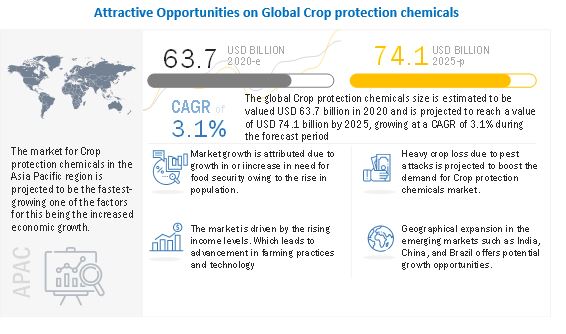
The global crop protection chemicals size is estimated to be valued USD 63.7 billion in 2020 and is projected to reach a value of USD 74.1 billion by 2025, growing at a CAGR of 3.1% during the forecast period. The crop protection chemicals market is a rapidly growing industry that plays a crucial role in ensuring food security for the growing population. These chemicals are used to protect crops from pests, diseases, and weeds, which can cause significant damage to crops and reduce yields. The market for crop protection chemicals has experienced significant growth in recent years, driven by the increasing demand for food, as well as the need to improve crop yields to meet the demands of a growing population.

One of the key drivers of the crop protection chemicals market is the increasing demand for food. With the global population expected to reach 9.7 billion by 2050, the demand for food is projected to increase by 70% over the next 30 years. This increase in demand for food will require farmers to produce more crops on the same amount of land, which will require the use of crop protection chemicals to protect against pests, diseases, and weeds.
Another key driver of the crop protection chemicals market is the need to improve crop yields. In recent years, there has been a significant decline in crop yields due to factors such as climate change, soil degradation, and the increasing prevalence of pests and diseases. This decline in crop yields has led to a growing demand for crop protection chemicals that can help farmers to increase their yields and improve their profits.
The crop protection chemicals market is also driven by the increasing use of precision agriculture techniques. Precision agriculture is a modern farming practice that uses advanced technologies such as GPS, remote sensing, and big data analytics to optimize crop yields. These technologies allow farmers to precisely target their crop protection chemicals to specific areas of their fields, which can help to reduce the amount of chemicals used and improve the efficiency of the application.
Despite the growing demand for crop protection chemicals, there are also several challenges facing the market. One of the key challenges is the increasing resistance of pests and diseases to chemical treatments. This resistance is a result of the overuse of chemicals and the lack of diversity in crop rotations, which has led to the development of pests and diseases that are resistant to chemical treatments.
Another challenge facing the crop protection chemicals market is the increasing concern about the environmental impact of these chemicals. Crop protection chemicals can have a negative impact on the environment, including the contamination of water and soil, the destruction of beneficial insects, and the contamination of food.
In conclusion, the crop protection chemicals market is a rapidly growing industry that plays a crucial role in ensuring food security for the growing population. The market is driven by the increasing demand for food, the need to improve crop yields, and the increasing use of precision agriculture techniques. However, the market is also facing several challenges, including the increasing resistance of pests and diseases to chemical treatments and the increasing concern about the environmental impact of these chemicals. To overcome these challenges, farmers and chemical companies will need to work together to develop new and innovative crop protection chemicals that are more effective and have a lower environmental impact.